Transform Your Backyard into a Serene Japanese Garden: Discover Modern Design Ideas, DIY Tips, and Timeless Inspiration
Have you ever wished for a quiet corner where stress fades and nature takes center stage? For over a thousand years, Japanese garden design has offered precisely this—a harmonious blend of art, philosophy, and horticulture. Originating in Japan’s Heian period, these gardens were crafted as spaces for meditation, reflecting Buddhist ideals of simplicity and connection to the natural world.

Today, this ancient tradition resonates deeply with modern homeowners. Amid busy lives, people seek outdoor spaces that inspire calm without requiring vast acreage. Japanese gardens thrive in small backyards and urban settings, proving that tranquility isn’t tied to size.
Blow, you’ll learn how to channel the essence of Japan’s most iconic landscapes into your own yard. Whether you’re drawn to moss-covered stones, trickling water features, or minimalist gravel patterns, we’ll share actionable ideas to create a garden that balances tradition with personal style. Let’s begin.
The Essence of Japanese Garden Design
Core Principles Rooted in Philosophy
Japanese gardens are not merely collections of plants and stones—they are living expressions of Shinto, Buddhist, and Taoist philosophies. At their heart lies wabi-sabi, the acceptance of impermanence and imperfection. This principle is evident in moss-covered lanterns, asymmetrical rock groupings, and trees shaped by wind rather than shears. Unlike formal European gardens, which often prioritize symmetry, Japanese designs embrace natural irregularities to evoke a sense of timelessness.
Harmony with Nature (Shizen)
Every element in a Japanese garden reflects the surrounding ecosystem. Designers traditionally avoid importing non-native plants or materials, instead highlighting local geology and flora. For example, a garden in the Pacific Northwest might use native ferns and cedar, while a Southwest design could incorporate desert grasses and sandstone. The goal is to create a seamless transition between the cultivated space and the wild landscape beyond.
Symbolism and Storytelling
Japanese gardens are rich in metaphor. A single upright stone might represent Mount Fuji, while a winding path symbolizes life’s journey. Even the arrangement of rocks follows strict symbolic rules:
- Triangular groupings (heaven, earth, humanity)
- Flat stones for stability and meditation
- Vertical stones to evoke forests or mountains
Water, whether real or implied through raked gravel, signifies renewal and flow. Dry landscapes (kare-sansui), like Kyoto’s Ryoan-ji Temple garden, use carefully placed rocks and swirling gravel patterns to mimic rivers and oceans, inviting viewers to “see” water through abstraction.
Mindfulness and Asymmetry
Balance in Japanese gardens is achieved through asymmetry, avoiding mirror-like repetition. A large boulder on one side of a pond might be balanced by a cluster of smaller stones on the opposite shore. This technique creates dynamic tension, guiding the eye to explore the space slowly.
Japanese Garden Design Layout: Planning Your Space
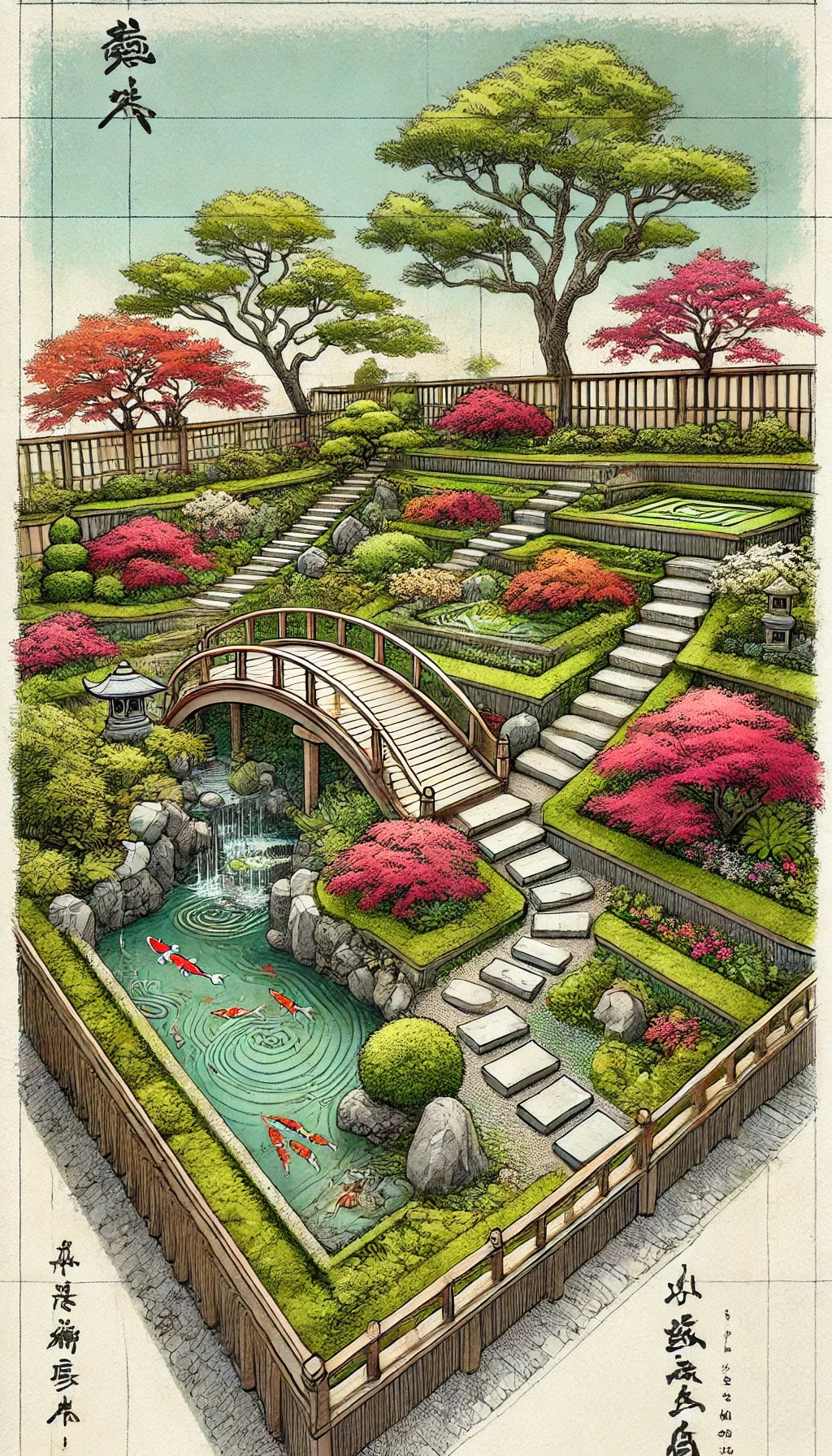
Step 1: Observe and Adapt
Begin by studying your yard’s natural features for a week. Note where sunlight falls, how wind patterns affect plant movement, and where water naturally pools after rain. Japanese gardens work with the land, not against it. For sloped yards, consider terracing with retaining walls made of local stone. Flat spaces might benefit from a gently raised hill (tsukiyama) to add dimension.
Step 2: Zones and Flow
Divide your garden into three functional zones:
- Active Zone: A tea house, seating area, or deck for gatherings.
- Transitional Zone: Pathways (roji) leading to quiet spaces, lined with ferns or low shrubs.
- Contemplative Zone: A secluded area with a stone bench, water basin, or Zen gravel garden.
Step 3: Pathways as Guides
Paths in Japanese gardens are never straight. Use materials that force a slower pace:
- Stepping stones (tobi-ishi): Irregularly shaped and spaced to encourage mindfulness.
- Flat slabs (nobedan): Ideal for connecting seating areas.
- Bridges (yatsuhashi): Zigzag wooden bridges over ponds symbolize life’s unexpected turns.
Step 4: Water as a Focal Point
Even in small spaces, water can play a role:
- Ponds: Stock with koi (nishikigoi) and surround with iris or water lilies.
- Streams: Use local stone to create a meandering channel.
- Dry Water Features: Rake gravel into wave patterns around stone “islands.”
Step 5: Plant Layering
Layer plants to mimic natural forests:
- Canopy: Japanese maple (momiji), pine (matsu), or cherry (sakura).
- Mid-Layer: Azaleas (tsutsuji), camellias (tsubaki), or bamboo.
- Ground Cover: Moss (koke), mondo grass (Ophiopogon), or creeping thyme.
Pro Tip: Use the “70-30 Rule”—70% evergreen plants for year-round structure, 30% seasonal plants (like maples or peonies) for fleeting beauty.
Modern Japanese Garden Design: Blending Tradition with Contemporary Style
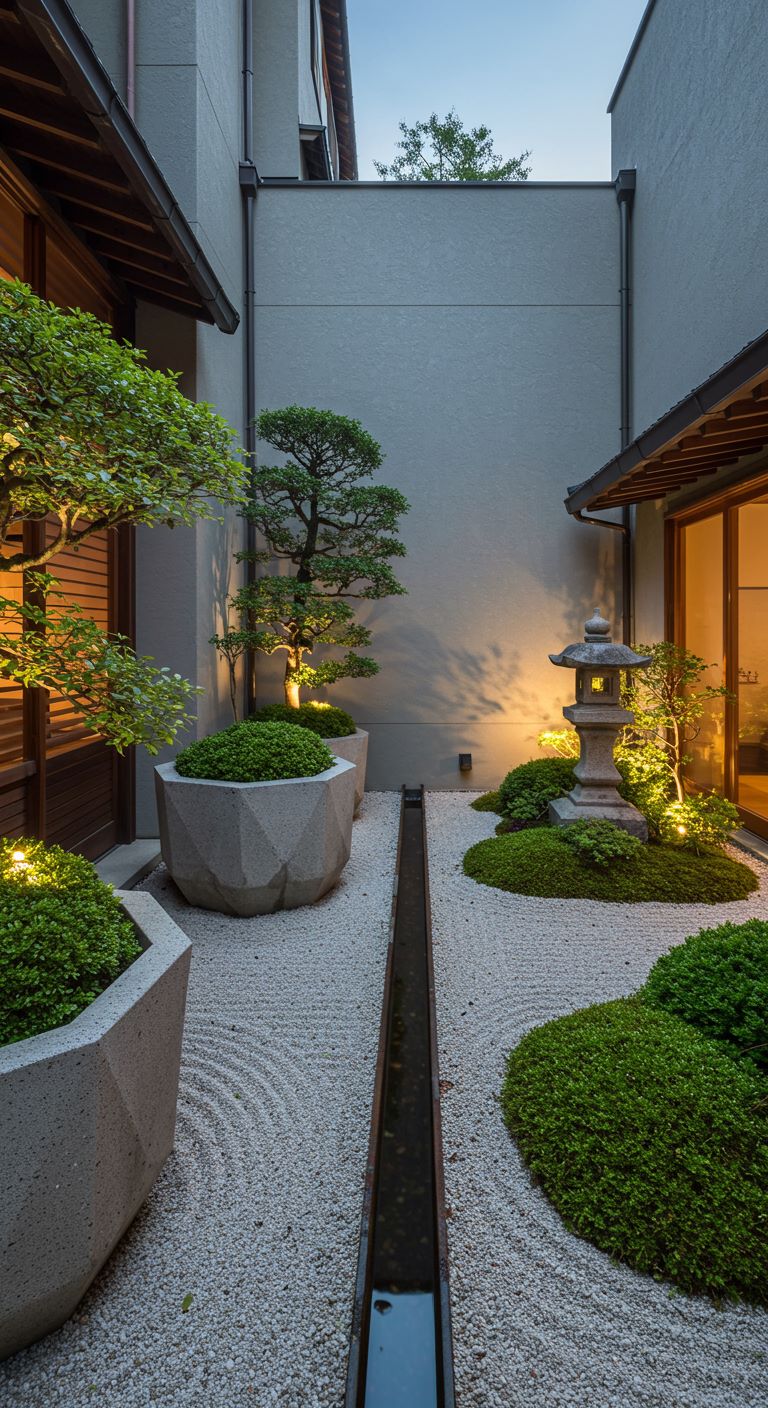
How do you honor centuries-old principles while embracing today’s aesthetics? Modern Japanese garden design answers this by pairing minimalism with meaningful contrasts. Think smooth concrete slabs alongside jagged basalt stones, or a single crimson maple tree framed by monochromatic gravel.
Materials like corten steel, glass, and polished concrete replace traditional wood in structures, offering durability without losing serenity. A raised steel trough can mimic a mountain stream, while recessed LED lights illuminate pathways without disrupting the garden’s natural rhythm.
Technology integrates subtly. Solar-powered pumps recirculate water in self-sustaining ponds, and weather-resistant speakers can play ambient sounds of rainfall. The goal? Preserve tranquility while simplifying upkeep.
Japanese Garden Design for Backyards: Small Spaces, Big Impact
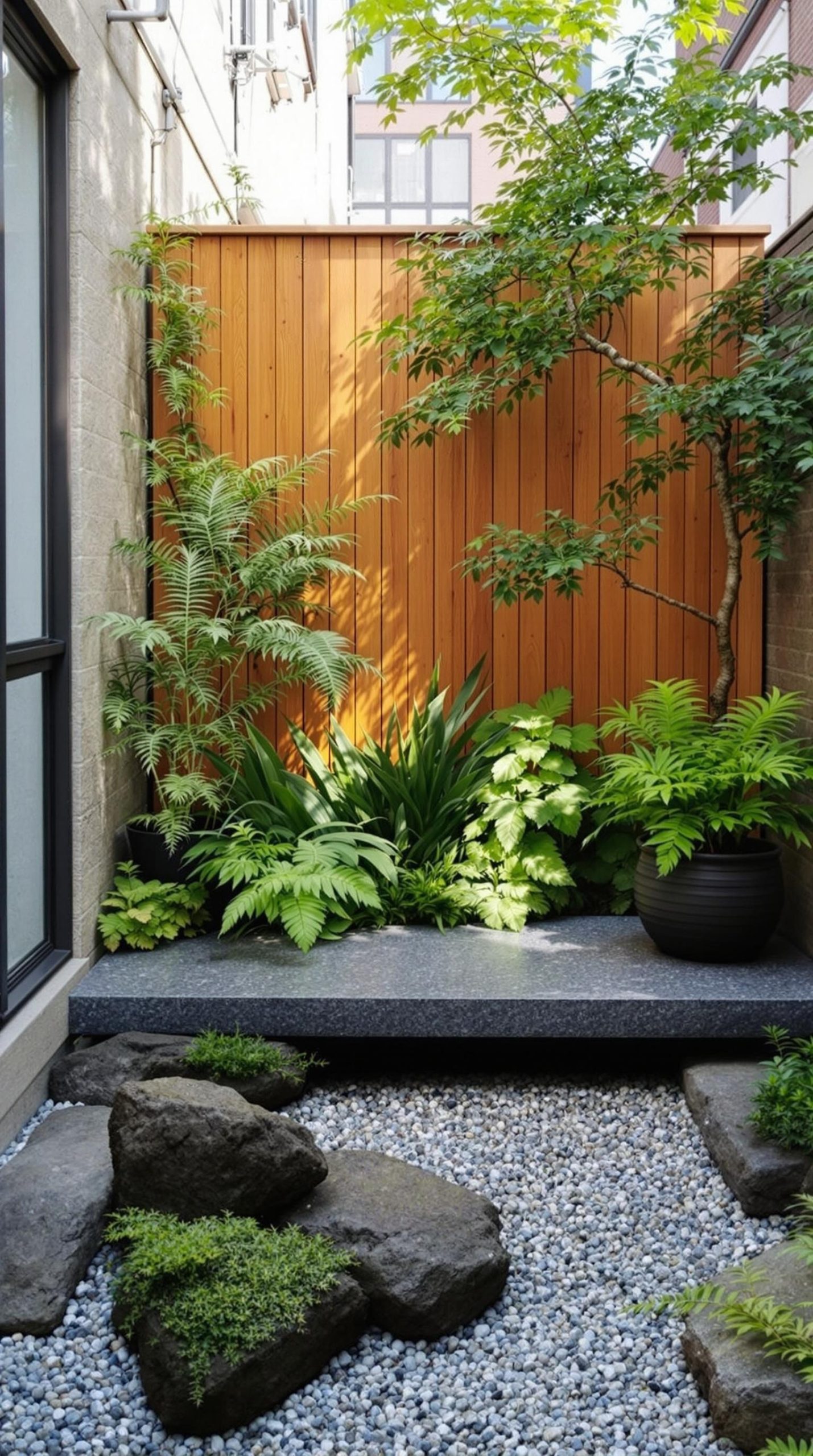
Creating a Japanese garden in a compact backyard isn’t just possible—it’s an opportunity to distill design principles into their purest form. Here’s how to maximize every square foot while preserving authenticity:
Vertical Gardening Techniques
Walls and fences become canvases for greenery using vertical gardening techniques. Instead of letting boundaries limit your space, transform them:
- Living Walls: Mount wooden lattices or metal grids to support climbing plants like akebia (chocolate vine) or Schizophragma hydrangeoides. These species offer seasonal interest with flowers and foliage without overwhelming structures.
- Moss Art: Attach reclaimed wooden panels to walls and cultivate sheet moss (Hypnum), which thrives in shade. Mist regularly to maintain its velvety texture.
- Hanging Elements: Suspend air plants (Tillandsia) in glass orbs or place potted bonsai on floating shelves. This draws the eye upward, creating layers without consuming floor space.
Illusion of Depth
Trick the eye into perceiving more space when planning gardens in small spaces:
- Mirror Placement: Position mirrors behind bamboo screens or within foliage to reflect greenery without obvious reflections. Use aged, frameless mirrors to avoid a modern aesthetic clash.
- Forced Perspective: Place larger stones or plants in the foreground and smaller ones farther back. A single dwarf maple (Acer palmatum ‘Sharp’s Pygmy’) near a gate can make a narrow yard feel deeper.
- Curved Pathways: Design winding stepping stone paths that disappear behind shrubs or screens, suggesting unseen areas.
Compact Water Features
Water symbolizes life and movement, even in miniature:
- Tabletop Tsukubai: Carve a shallow basin from granite or repurpose a stone sink. Add a bamboo spout (kakei) that drips water into the basin, recycling it via a hidden submersible pump.
- Wall-Mounted Waterfalls: Install a slim copper or bamboo channel along a fence, allowing water to trickle into a gravel-filled base. The sound masks urban noise while fitting into a 2-foot-wide footprint.
- Reflective Dishes: Use wide, shallow ceramic bowls as still pools. Float a single water lily leaf or uki (island) stone to evoke a pond.
Plant Selection for Small Spaces
Choose plants that offer year-round structure without overcrowding:
- Dwarf Conifers: Pinus densiflora ‘Umbraculifera’ (Tanyosho pine) grows slowly into a sculptural, umbrella-like form.
- Grasses: Hakonechloa macra (Japanese forest grass) cascades gracefully from containers, softening edges.
- Moss Alternatives: In dry climates, substitute moss with Dymondia margaretae or Sedum spurium for similar texture.
Case Study: A 10×12-Foot Urban Oasis
A Brooklyn homeowner transformed a concrete patio using:
A reclaimed granite slab as a tea ceremony platform.
The result? A space that feels expansive through layered textures and hidden details..
A 3-foot-wide gravel “stream” with raked waves.
A vertical cedar screen supporting potted ferns and Fatsia japonica.
Japanese Garden Features: Key Elements to Include
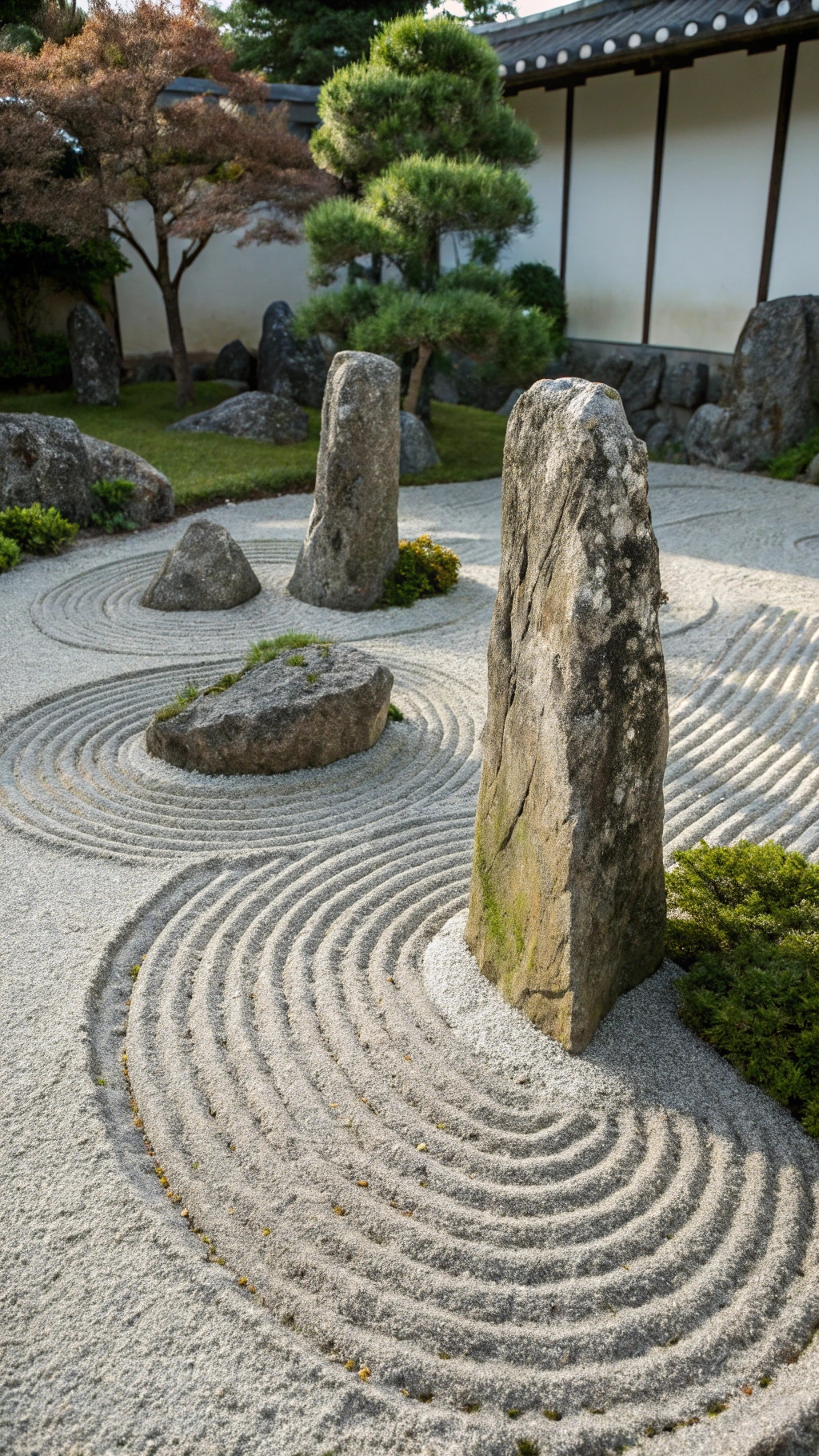
Every Japanese garden relies on purposeful elements that tell a story. Start with these essentials:
- Koi ponds and tsukubai: Water symbolizes purity and life. A small pond with koi adds movement, while a stone basin (tsukubai) near seating areas invites ritual handwashing.
- Stone lanterns (tōrō): Originally guiding tea ceremony guests, these cast soft shadows and mark transitions between garden zones.
- Bamboo fences: Split bamboo screens (sudare) or low fences (takegaki) create privacy and frame views without blocking light.
- Zen dry landscapes (kare-sansui): Raked gravel or sand mimics water ripples around stones, offering a meditative focal point.
- Pruned trees and moss: Cloud-pruned pines symbolize endurance, while moss carpets evoke ancient forests.
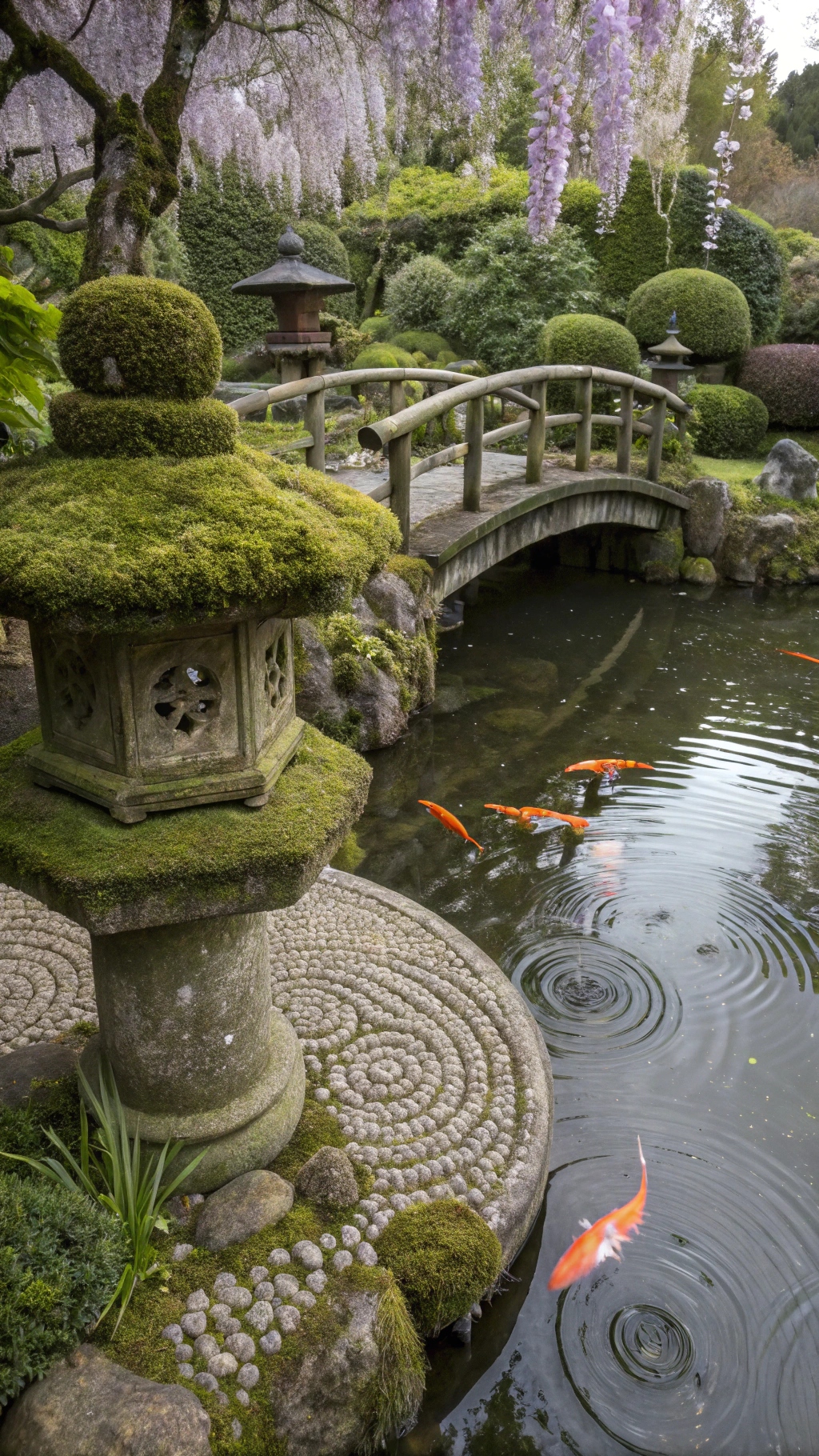
Each feature serves both aesthetic and philosophical roles, blending function with metaphor.
Japanese Garden Ideas: Inspiration for Every Style
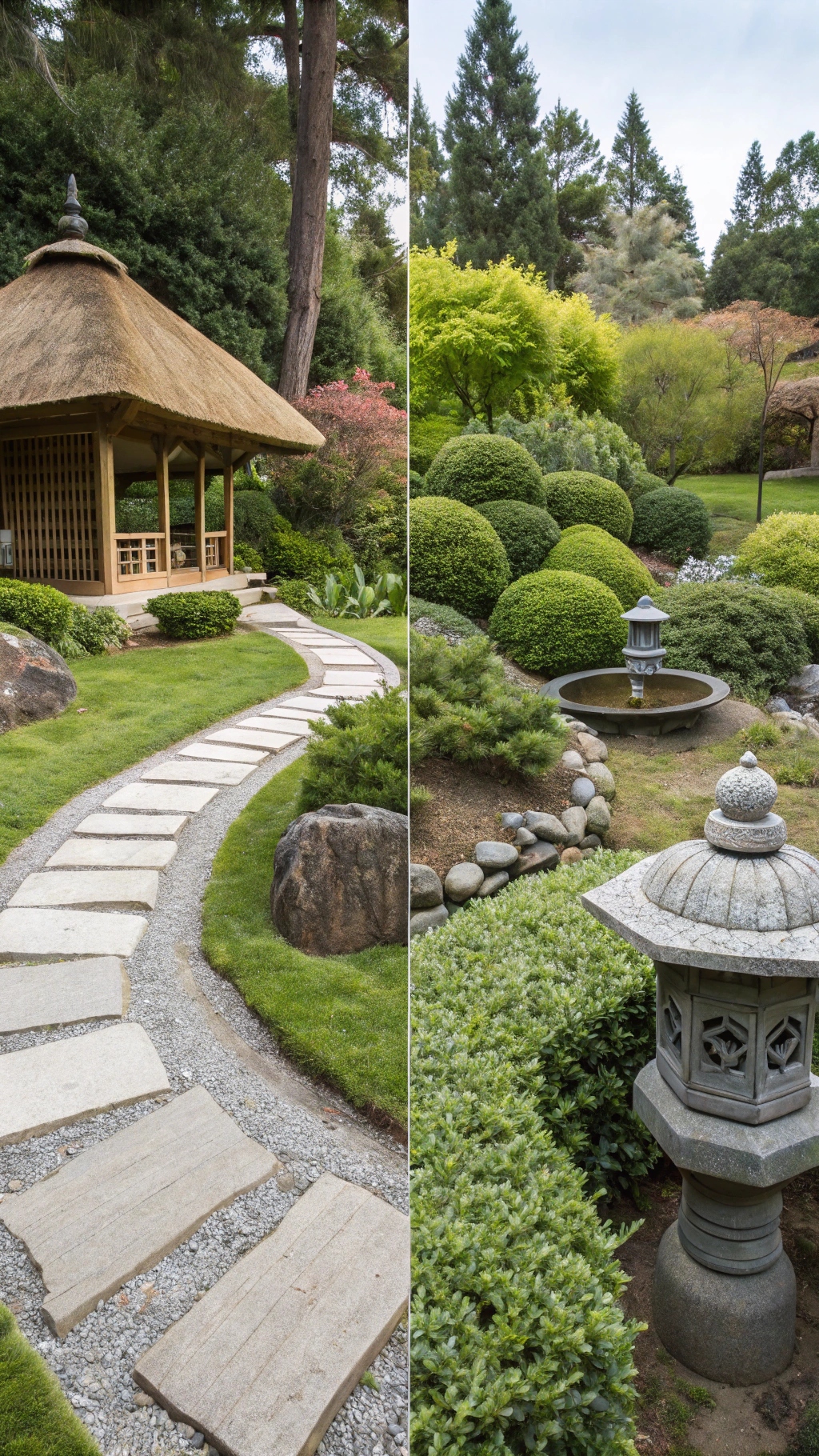
1. Tea Gardens (Chaniwa)
Historical Roots: Developed during the Muromachi period (1336–1573), tea gardens were designed for the chanoyu (tea ceremony). Every element fosters mindfulness and humility.
Key Features:
- Roji (Dewy Path): A stepping stone path leading to the tea house, symbolizing the transition from the mundane world.
- Tsukubai: A stone basin for ritual handwashing, often accompanied by a bamboo ladle and lantern.
- Plant Palette: Evergreens like pine and camellia for structure, with seasonal accents like sasa bamboo or autumn maple.
Modern Twist: Replace traditional tea houses with a minimalist cedar pavilion or a shaded bench. Use reclaimed bricks for the path to blend old and new.
2. Stroll Gardens (Kaiyū-shiki-teien)
Design Philosophy: Meant to be explored, these gardens reveal hidden vistas at every turn. Popularized in the Edo period, they often include ponds, islands, and bridges.
Layout Tips:
- Circular Pathways: Create a loop that passes through distinct “scenes”—a waterfall, a moon-viewing deck, a grove of cherry trees.
- Seasonal Highlights: Plant sakura (cherry) for spring, ajisai (hydrangea) for summer, and momiji (maple) for autumn drama.
- Focal Points: Add a wooden arbor overlooking a koi pond or a rustic gazebo framed by wisteria.
Example: Portland Japanese Garden’s Stroll Garden uses elevation changes and strategic plantings to mimic the landscapes of Kyoto.
3. Courtyard Gardens (Tsubo-niwa)
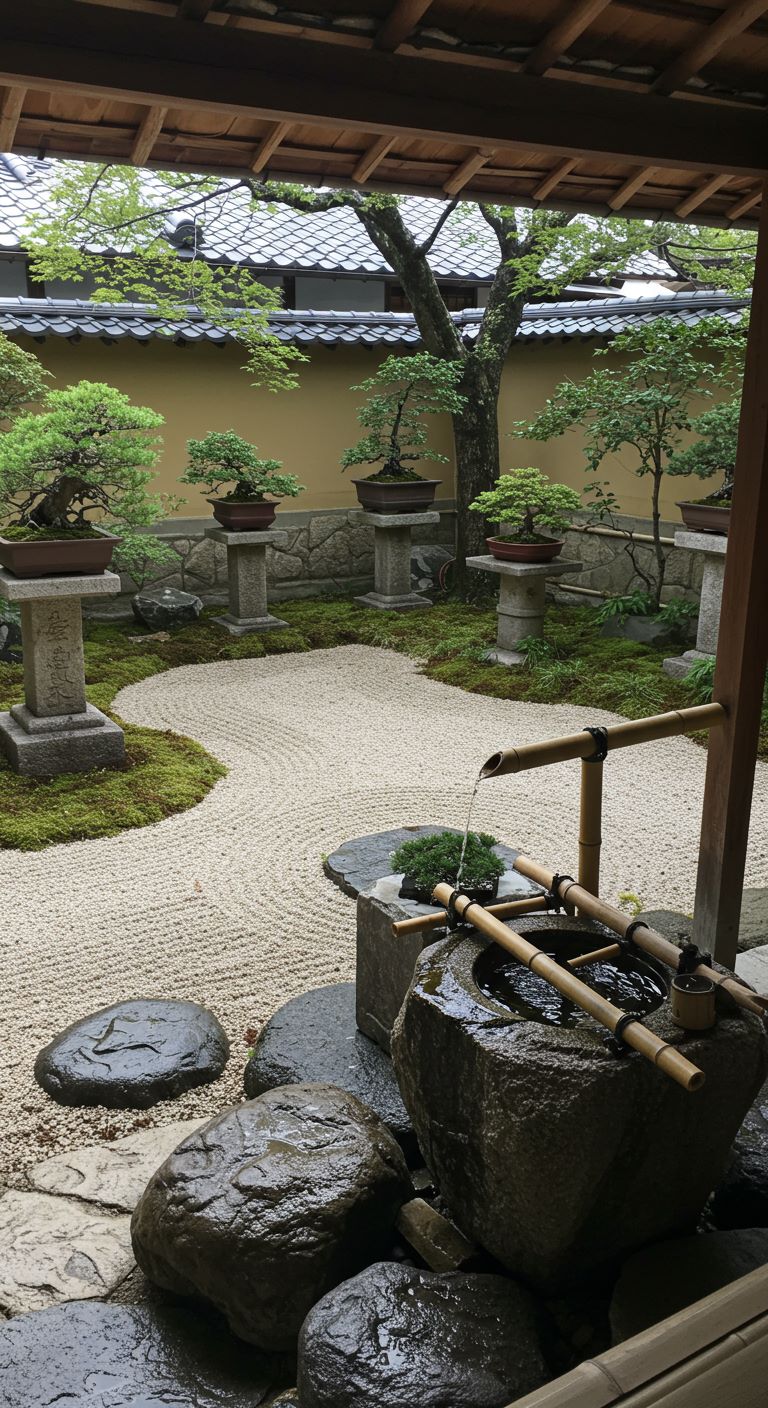
Urban Adaptations: Originating in crowded Edo-era cities, these micro-gardens maximize minimal space (1 tsubo = ~36 sq ft).
Elements to Include:
- Vertical Greenery: Install a sudare (bamboo screen) with hanging shiso (perilla) or ferns.
- Water Sounds: A bamboo shishi-odoshi (deer scarer) trickles water into a stone basin, masking street noise.
- Multi-Functional Stones: Use flat stones as seating, stepping pads, or display surfaces for bonsai.
Case Study: A Tokyo apartment’s 6×6-foot balcony features a single Goyōmatsu (five-needle pine) in a ceramic pot, surrounded by white pebbles and a miniature lantern.
4. Zen Meditation Gardens (Karesansui)
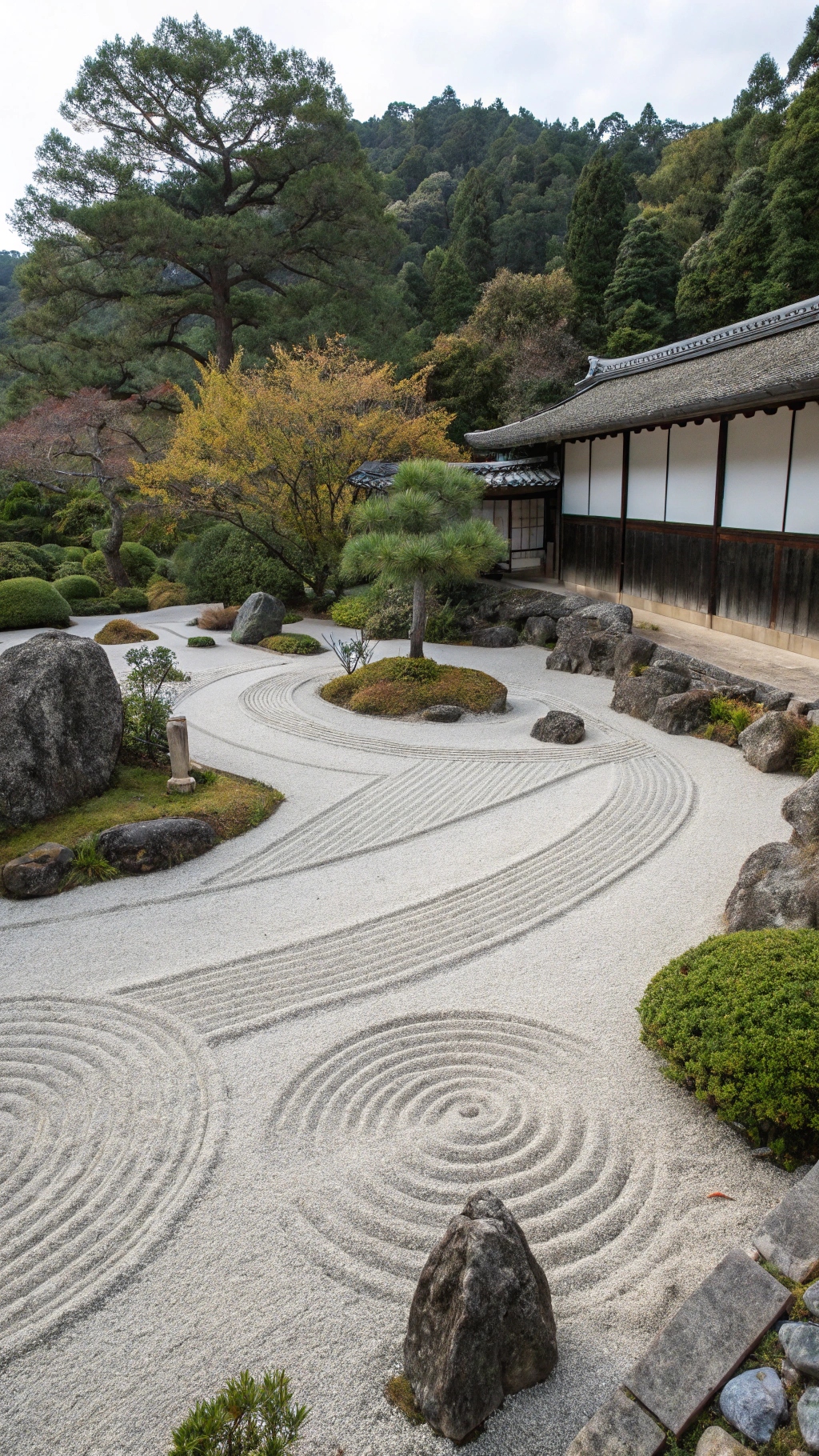
Minimalist Mastery: Born in Zen monasteries, these zen gardens take dry landscapes and use abstraction to provoke contemplation.
Design Principles:
- Raked Perfection: Use a wooden kumade (rake) to create precise gravel patterns—straight lines for calm, swirls for energy.
- Stone Arrangements: Group odd numbers of rocks (3, 5, or 7) to represent islands, mountains, or animals. Avoid symmetry.
- Borrowed Scenery (Shakkei): Frame distant elements like a neighbor’s pine tree or a hillside to expand the garden’s perceived boundaries.
Pro Tip: For low maintenance, use dark lava rock instead of gravel—it hides debris and contrasts sharply with pale sand.
5. Modern Fusion Gardens
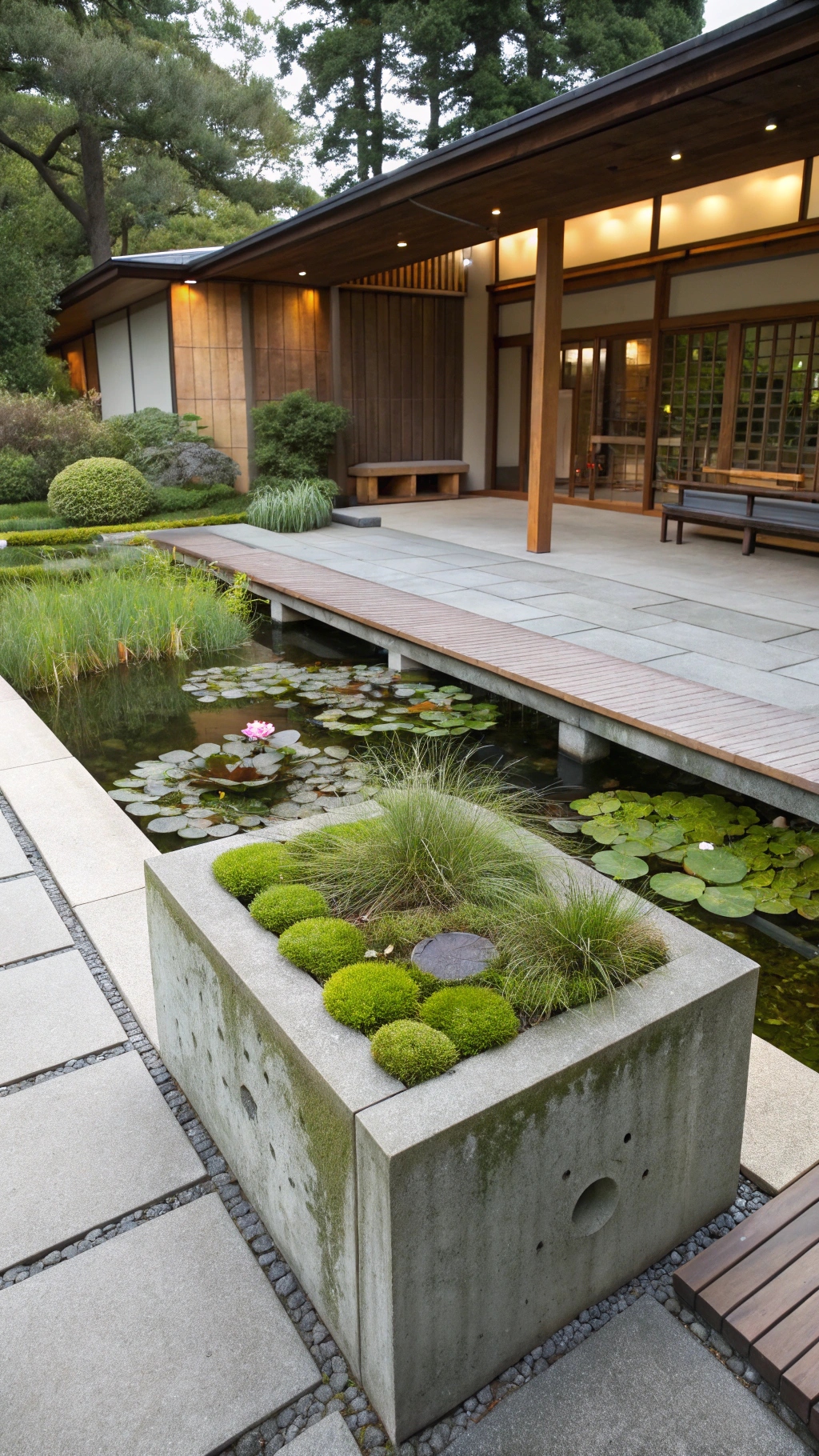
Bridging Eras: Combine traditional elements with contemporary materials for a fresh take.
Ideas:
- Concrete and Moss: Pour a geometric concrete planter and let moss colonize its edges.
- Steel Streams: Replace a pond with a corten steel trough filled with floating hashiba (lily pads).
- Lighting: Install recessed LED strips under benches to illuminate pathways without overpowering the ambiance.
Japanese Garden DIY – Tips for Creating Your Own Oasis
If you love to design and garden then the chances are that you will look to undertake as much of the project as you can yourself. These are several factors that you should consider and by studying the below steps you should be well on your way to achieving your perfect Japanese garden.
Step 1: Choosing the Right Plants
Regional Adaptations:
- Cold Climates: Substitute cherry trees with Amur maple (Acer ginnala), which offers fiery fall color.
- Arid Regions: Use Nandina domestica (heavenly bamboo) instead of true bamboo—it’s drought-tolerant and provides red berries.
Starter Plants: - Shade Lovers: Hostas, Japanese painted ferns.
- Sun Seekers: Iris ensata (Japanese water iris), Hakone grass.
Pro Tip: Source plants from local nurseries specializing in natives—they’ll thrive with less effort.
Step 2: Building a Dry Landscape (Karesansui)
Materials Needed:
- Crushed granite or coarse sand (2–3 inch depth).
- 3–5 weathered stones (basalt or limestone).
- Metal edging (optional, for containment).
Process:
- Outline the area with a garden hose to test shapes.
- Install edging if desired, burying it 1 inch below ground.
- Lay landscape fabric to suppress weeds.
- Add gravel/sand, then place stones using the “triangular rule” (no two aligned vertically).
- Rake patterns with a wide-toothed bamboo rake.
Maintenance: Refresh gravel annually and realign stones if settling occurs.
Step 3: Installing a Bamboo Fence
DIY Guide:
- Materials: Bamboo poles (1–2 inch diameter), copper wire, posthole digger, quick-setting concrete.
- Prep: Soak bamboo in water for 48 hours to increase flexibility.
- Posts: Set 4×4 wooden posts in concrete every 6 feet.
- Weave: Attach horizontal bamboo poles to posts using copper wire. For a takegaki fence, weave vertical poles through horizontals.
- Finish: Seal bamboo with linseed oil to prolong life.
Cost: ~
Step 4: Crafting a Stepping Stone Path
Materials: Irregular flagstones, sand, gravel.
Steps:
- Lay stones on the ground to test spacing (6–8 inches apart).
- Dig 2–3 inches into the soil for each stone.
- Fill holes with sand for leveling, then set stones.
- Plant moss or creeping thyme between gaps for softness.
Pro Tip: Place stones slightly off-center from one another to slow walking pace.
Step 5: Building a Mini Koi Pond
Budget-Friendly Version:
- Container: Use a preformed polyethylene pond (50–100 gallons).
- Location: Partial shade to prevent algae blooms.
- Setup:
- Bury the pond, leaving a 1-inch lip above ground.
- Add a small pump and filter.
- Edge with flat stones and Iris pseudacorus.
- Stocking: Start with 2–3 small koi and add water hyacinths for natural filtration.
Cost: ~$300 for a 75-gallon setup.
Japanese Garden Inspiration – Real-Life Examples and Case Studies
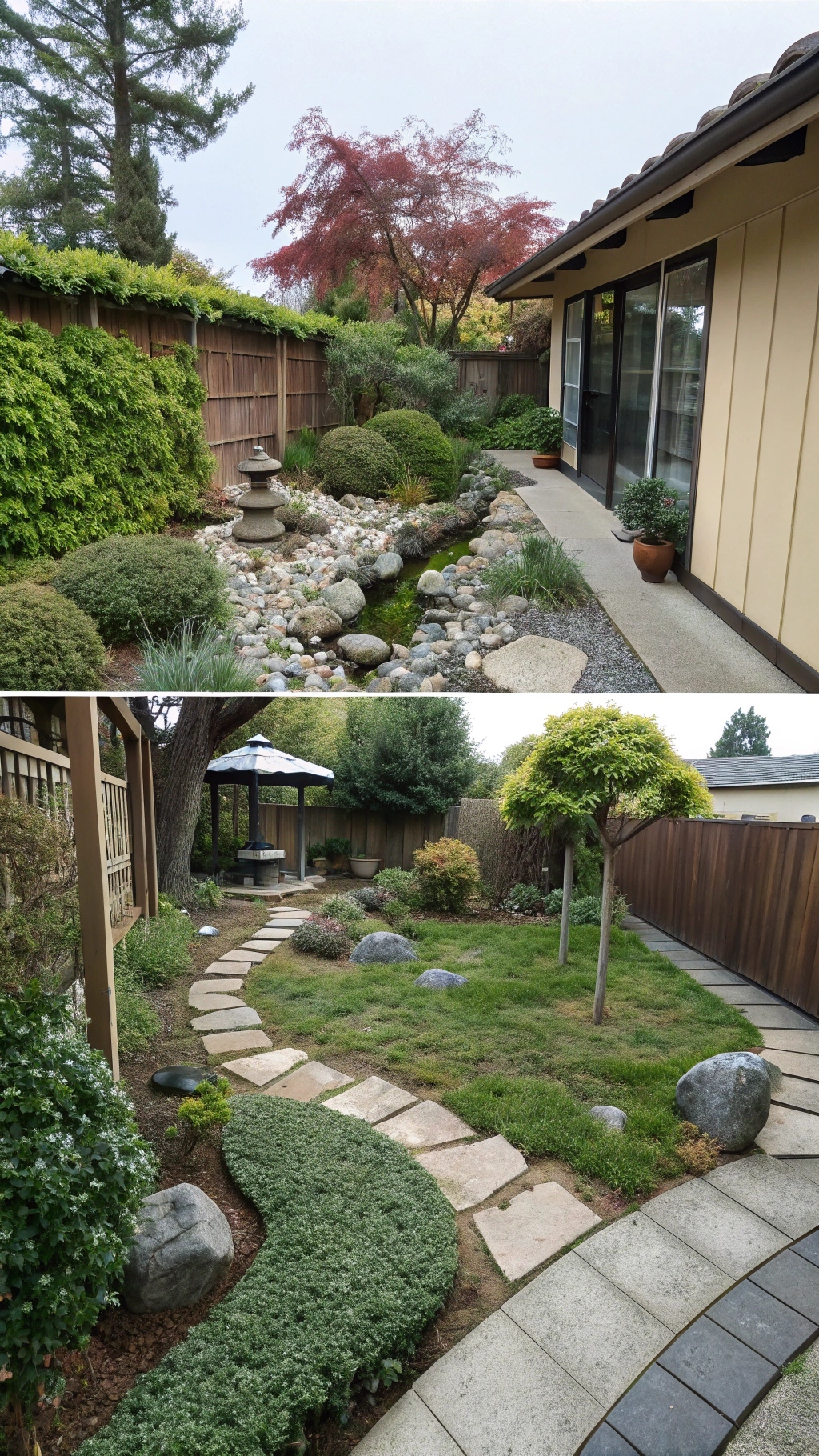
Iconic Japanese Gardens Around the World
- Ryoan-ji Temple (Kyoto, Japan)
- Design Highlight: The quintessential Zen dry landscape features 15 meticulously placed rocks on raked gravel, arranged so only 14 are visible from any angle. This design encourages introspection and embodies the concept of mu (nothingness).
- Why It Works: The simplicity forces viewers to engage imaginatively, “filling in” the missing rock through contemplation.
- Kenroku-en (Kanazawa, Japan)
- Design Highlight: One of Japan’s “Three Great Gardens,” it balances six attributes—spaciousness, serenity, antiquity, waterways, vistas, and artificiality. Notable for yukitsuri (snow ropes) protecting pine branches in winter.
- Why It Works: Seasonal elements like cherry blossoms and autumn maples ensure year-round interest, while teahouses offer framed views of the landscape.
- Portland Japanese Garden (Oregon, USA)
- Design Highlight: Blends traditional principles with Pacific Northwest flora. The Strolling Pond Garden features a 100-year-old moon bridge and a naturalistic waterfall using local basalt.
- Why It Works: Demonstrates how native plants (e.g., Douglas firs) can harmonize with Japanese aesthetics.
- Adachi Museum Garden (Shimane, Japan)
- Design Highlight: Uses shakkei (borrowed scenery) to incorporate distant mountains into the garden’s composition. The Moss Garden features 50+ moss varieties.
- Why It Works: Shows how scale and perspective can make even vast landscapes feel intimate.
Homeowner Case Studies
Case Study 1: Urban Rooftop Retreat (Tokyo, Japan)
- Challenge: A 200-square-foot rooftop with harsh winds and limited weight capacity.
- Solution:
- Vertical Layers: Installed lightweight aluminum trellises with akebia vines for shade.
- Dry Stream: Painted concrete to resemble a gravel riverbed, edged with dwarf mondo grass.
- Focal Point: A stainless steel tsukubai basin recirculating water via a solar pump.
- Result: A low-maintenance oasis that withstands urban conditions while offering serene views.
Case Study 2: Subyard Transformation (California, USA)
- Challenge: A 1,500-square-foot yard dominated by invasive ivy and uneven terrain.
- Solution:
- Terracing: Built retaining walls with salvaged sandstone to create tiered planting beds.
- Koi Pond: Used a preformed liner and stocked with butterfly koi for movement.
- Plant Palette: Combined Japanese maples, azaleas, and California-native sedges for drought tolerance.
- Result: A hybrid garden that respects local ecology while evoking Kyoto’s elegance.
Maintaining Your Japanese Garden – Tips for Long-Term Beauty
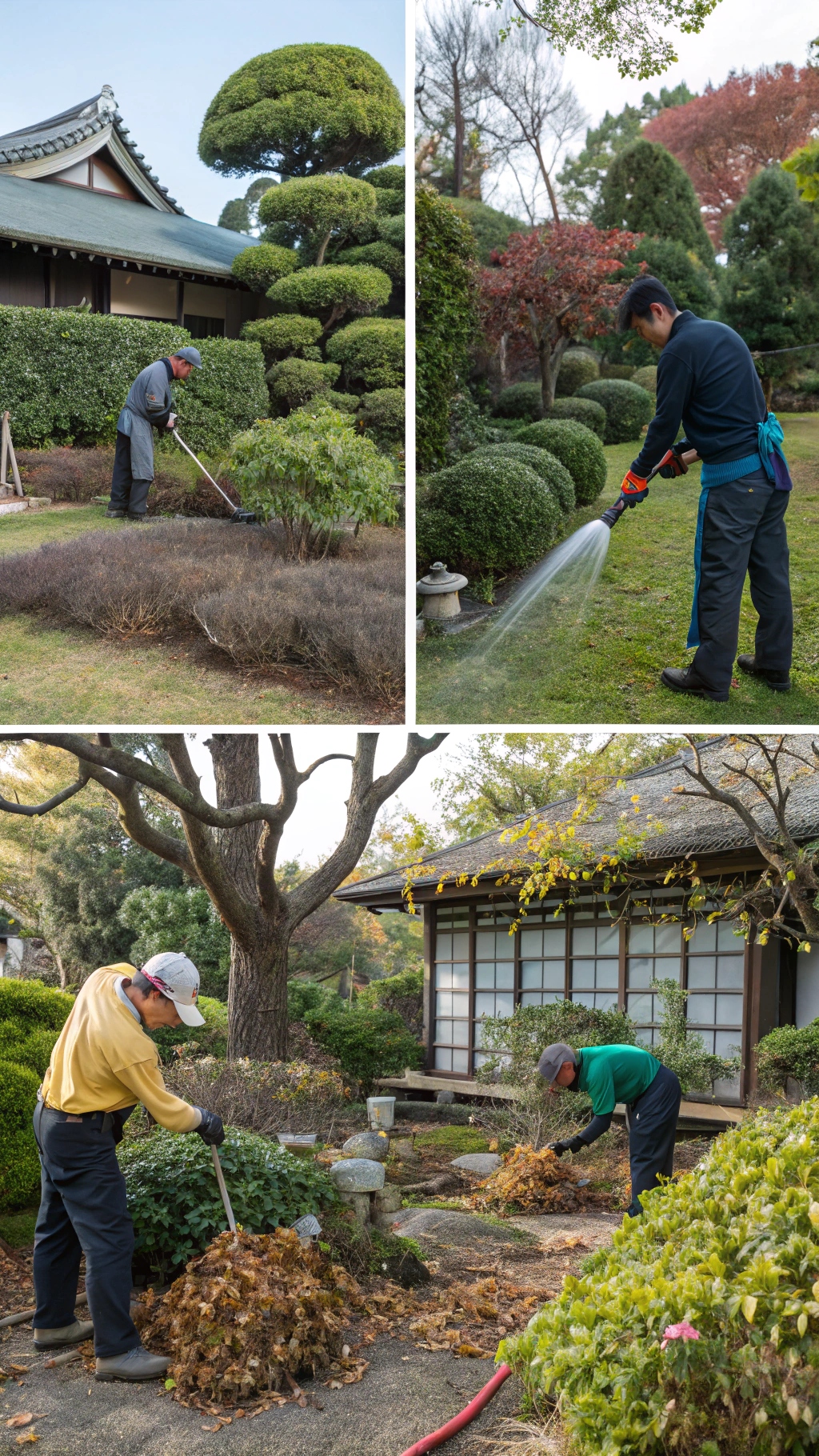
Seasonal Maintenance Guide
Spring
- Pruning: Trim dead branches from pines and azaleas after the last frost. Use nibble cuts to maintain natural shapes.
- Moss Care: Remove debris with a soft broom. Apply buttermilk to bare patches to encourage growth.
- Water Features: Clean pond filters and refill basins. Introduce barley straw to control algae naturally.
Summer
- Watering: Water early morning to reduce evaporation. Drip irrigation works best for moss and ferns.
- Pest Control: Hand-pick aphids from maples. Use neem oil for severe infestations.
- Gravel Raking: Refresh dry garden patterns weekly to maintain crisp lines.
Autumn
- Leaf Management: Net ponds to catch falling leaves. Mulch shredded leaves into planting beds.
- Winter Prep: Wrap delicate trees like Acer palmatum in burlap to protect from frost.
Winter
- Snow Protection: Brush heavy snow off bamboo fences to prevent cracking.
- Tool Maintenance: Sharpen shears and oil wooden rake handles to prevent rot.
Troubleshooting Common Issues
- Algae in Ponds
- Fix: Add floating plants (e.g., water lettuce) to shade the water. Use a UV clarifier for persistent blooms.
- Moss Browning
- Fix: Test soil pH—moss thrives in acidic conditions (5.5–6.0). Mist with rainwater if tap water is alkaline.
- Bamboo Splitting
- Fix: Seal cuts with wood glue and sand edges. Replace severely cracked poles during spring.
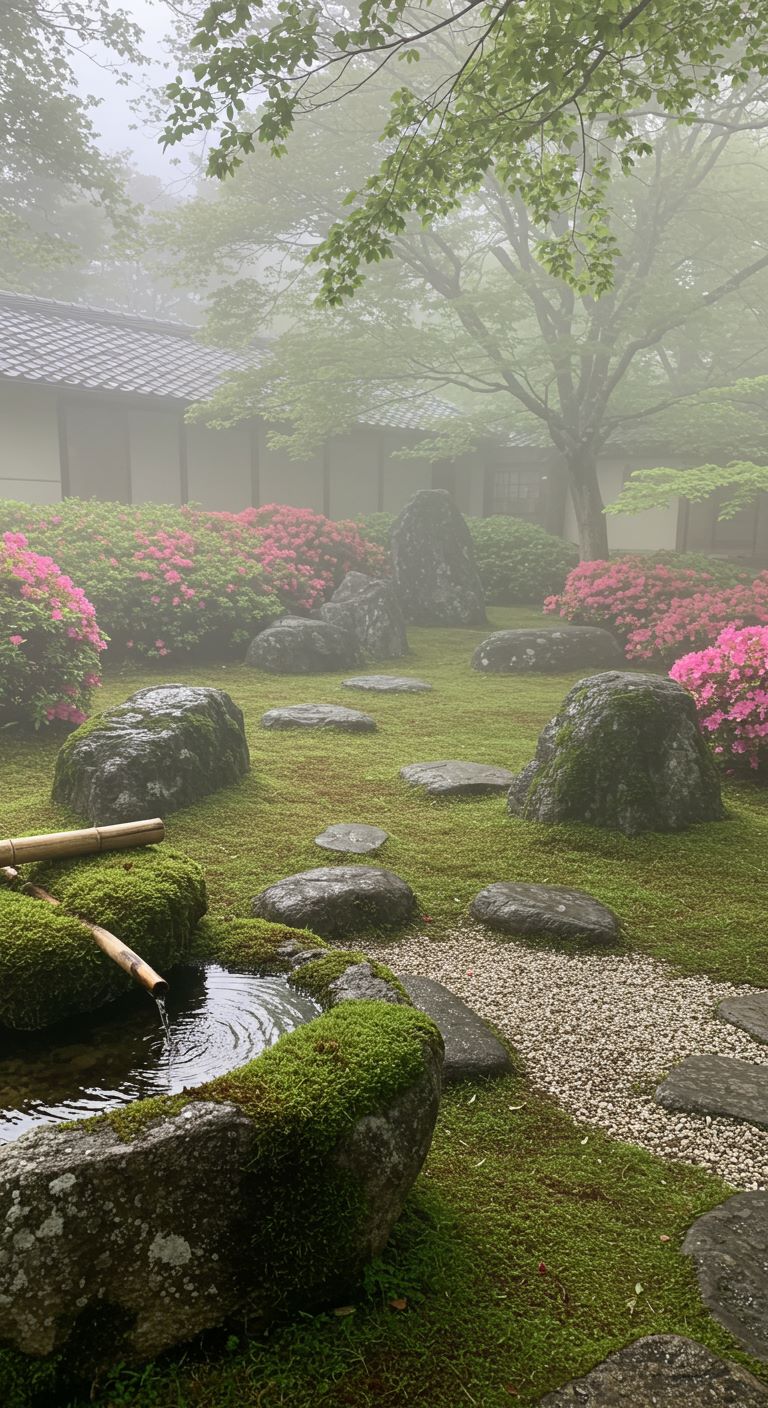
Mindful Upkeep Practices
- Daily Rituals: Spend 10 minutes raking gravel or inspecting plants. This meditative routine deepens your connection to the garden.
- Repairs with Intention: When a stone lantern chips, highlight the flaw with moss or lichen—a nod to wabi-sabi.
- Record Changes: Keep a journal tracking plant growth, wildlife sightings, and seasonal shifts. Over time, this becomes a living history of your garden.
Pro Tip: Involve family members in raking patterns or feeding koi. These shared moments turn maintenance into meaningful tradition.
Last Thoughts: Cultivating Timelessness
A Japanese garden is never truly “finished.” It evolves with the seasons, weather, and your personal journey. Whether you’re realigning a stepping stone or replanting moss, each act of care renews the garden’s spirit. Start small—a single lantern, a potted maple—and let the space grow alongside your understanding of its rhythms. In the quiet moments spent tending gravel or watching koi glide, you’ll find the stillness that defines these living artworks. Your sanctuary awaits.
